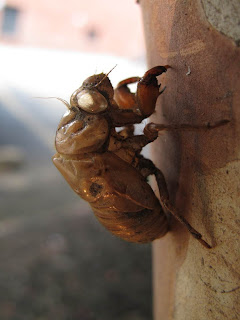Where I grew up in (and later right outside of) Detroit, MI, the local cicadas were the annual, “dog-day” cicadas whose calls signaled the end of summer and the approach of the school year and fall. They had a hypnotic eeeeeooooo-eeeeeeeoooo call that seemed to suggest the inexorable change of seasons and the passage of time.
Here in DC the cicadas are also pretty predictable summer noisemakers—none of this periodical nonsense, thank you very much—but these cicadas make more of a revving sound as they lure their mates, and they arrive much earlier in the summer with no regard for their potential usefulness as metaphorical heralds.
Nonetheless, since it’s always rarer to see them than hear them, I like to observe evidence of their presence, even if it’s evidence of their immature, younger selves. I spotted this husk—the old shell of the cicada’s nymph life—clinging as with a life of its own to a tree along my route home from work, and it was at once so familiar to me from childhood and so damn bizarre that I had to take a picture of it.
Cicadas are fascinating creatures whose life-cycle patterns differ widely from our own: they live underground as flightless nymphs for several years (sometimes even 13-17 years, as in the case of periodical cicadas—but we’re not talking about them) before tunneling up to the surface, crawling up a tree or shrub, breaking free of their nymph shell, and become winged, siren-calling adults for just a brief (but sex-filled) one- or two-month season. Before they die, females lay eggs inside of twigs; then young hatch out, burrow into the ground, and the cycle begins all over again.
I’m sure there’s a joke in there somewhere about how some humans, too, spent the vast majority of their lives sexually immature and in the dark—but seriously, imagine spending most of your life as a juvenile. Would all cicada books be young-adult literature?
The great thing about cicadas is that, as with fireflies, their cycles make an impression on, and create associations with, our cycles, and for those of us who grew up with them, summer wouldn’t be the same without them.
If you miss the cicadas of your youth or just have an unnatural interest in noisy insects, you can visit this page from the University of Michigan Museum of Zoology to hear the calls of a whole bunch of different kinds of cicadas. (For those of you from southeast Michigan, I think the eeeeeoooo guys are Tibicen pruinosus.)
Are there insects, or other “everyday” fauna, that mean summer to you?
Here in DC the cicadas are also pretty predictable summer noisemakers—none of this periodical nonsense, thank you very much—but these cicadas make more of a revving sound as they lure their mates, and they arrive much earlier in the summer with no regard for their potential usefulness as metaphorical heralds.
Nonetheless, since it’s always rarer to see them than hear them, I like to observe evidence of their presence, even if it’s evidence of their immature, younger selves. I spotted this husk—the old shell of the cicada’s nymph life—clinging as with a life of its own to a tree along my route home from work, and it was at once so familiar to me from childhood and so damn bizarre that I had to take a picture of it.
Cicadas are fascinating creatures whose life-cycle patterns differ widely from our own: they live underground as flightless nymphs for several years (sometimes even 13-17 years, as in the case of periodical cicadas—but we’re not talking about them) before tunneling up to the surface, crawling up a tree or shrub, breaking free of their nymph shell, and become winged, siren-calling adults for just a brief (but sex-filled) one- or two-month season. Before they die, females lay eggs inside of twigs; then young hatch out, burrow into the ground, and the cycle begins all over again.
I’m sure there’s a joke in there somewhere about how some humans, too, spent the vast majority of their lives sexually immature and in the dark—but seriously, imagine spending most of your life as a juvenile. Would all cicada books be young-adult literature?
The great thing about cicadas is that, as with fireflies, their cycles make an impression on, and create associations with, our cycles, and for those of us who grew up with them, summer wouldn’t be the same without them.
If you miss the cicadas of your youth or just have an unnatural interest in noisy insects, you can visit this page from the University of Michigan Museum of Zoology to hear the calls of a whole bunch of different kinds of cicadas. (For those of you from southeast Michigan, I think the eeeeeoooo guys are Tibicen pruinosus.)
Are there insects, or other “everyday” fauna, that mean summer to you?
{A note: I do write all text and take all pictures. Please do not reproduce either without my permission.}






































